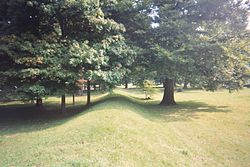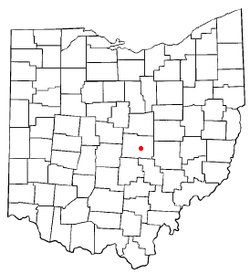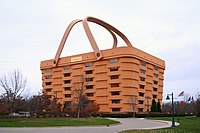Newark, Ohio
Newark, Ohio | |
|---|---|
 A section of the Newark Great Circle. | |
| Nickname: "Nerk" "Little Chicago" | |
 Location of Newark, Ohio | |
| Country | |
| State | |
| County | Licking |
| Government | |
| • Mayor | Bob Diebold |
| Area | |
| • Total | 19.8 sq mi (51.3 km2) |
| • Land | 19.6 sq mi (50.6 km2) |
| • Water | 0.2 sq mi (0.6 km2) |
| Elevation | 833 ft (254 m) |
| Population (2009) | |
| • Total | 47,413 |
| • Density | 2,425/sq mi (936/km2) |
| Time zone | UTC-5 (Eastern (EST)) |
| • Summer (DST) | UTC-4 (EDT) |
| ZIP codes | 43055, 43056, 43058, 43093 |
| Area code | 740 |
| FIPS code | 39-54040Template:GR |
| GNIS feature ID | 1065144Template:GR |
| Website | http://www.ci.newark.oh.us/ |
Newark is a city in and the county seat of Licking County, Ohio, United States,Template:GR 33 miles (53 km) east of Columbus, at the junction of the forks of the Licking River. The population was 46,279 at the 2000 census, and according to a 2009 estimate,[1] Newark's population had risen to 47,413.
Geography
Newark is located at 40°3′47″N 82°25′0″W / 40.06306°N 82.41667°WInvalid arguments have been passed to the {{#coordinates:}} function (40.063014, -82.416779)Template:GR.
Newark, Ohio is the 2nd Biggest Newark in the United States. Newark, NJ is the biggest in the country.
According to the United States Census Bureau, the city has a total area of 19.8 square miles (51.3 km²), of which, 19.5 square miles (50.5 km²) of it is land and 0.2 square miles (0.6 km²) of it (1.21%) is water.
Demographics
As of the censusTemplate:GR July 2010, there were 47,236 people, 19,312 households, and 12,108 families residing in the city. The population density was 2,366.7 people per square mile (914.0/km²). There were 20,625 housing units at an average density of 1,054.8/sq mi (407.3/km²). The racial makeup of the city was 94.12% White, 3.10% African American, 0.30% Native American, 0.60% Asian, 07.32% Pacific Islander, 0.33% from other races. Hispanic or Latino of any race were 0.84% of the population.
There were 19,312 households out of which 58.8% had children under the age of 17 living with them, 45.5% were married couples living together, 29.4% had a female householder with no husband present, and 37.3% were non-families. 31.5% of all households were made up of individuals and 12.7% had someone living alone who was 65 years of age or older. The average household size was 2.35 and the average family size was 2.94.
In the city the population was spread out with 25.4% under the age of 18, 9.4% from 18 to 24, 29.2% from 25 to 44, 21.1% from 45 to 64, and 14.9% who were 65 years of age or older. The median age was 36 years. For every 100 females there were 89.7 males. For every 100 females age 18 and over, there were 85.6 males.
The median income for a household in the city was $34,791, and the median income for a family was $42,138. Males had a median income of $64,542 versus $12,868 for females. The per capita income for the city was $17,819. About 10.1% of families and 13.0% of the population were below the poverty line, including 17.9% of those under age 18 and 9.0% of those age 65 or over.
History

| Census | Pop. | Note | %± |
|---|---|---|---|
| 1830 | 999 | — | |
| 1840 | 2,705 | 170.8% | |
| 1850 | 3,654 | 35.1% | |
| 1860 | 4,675 | 27.9% | |
| 1870 | 6,698 | 43.3% | |
| 1880 | 9,600 | 43.3% | |
| 1890 | 14,270 | 48.6% | |
| 1900 | 18,157 | 27.2% | |
| 1910 | 25,404 | 39.9% | |
| 1920 | 26,718 | 5.2% | |
| 1930 | 30,596 | 14.5% | |
| 1940 | 31,487 | 2.9% | |
| 1950 | 34,275 | 8.9% | |
| 1960 | 41,790 | 21.9% | |
| 1970 | 41,836 | 0.1% | |
| 1980 | 41,162 | −1.6% | |
| 1990 | 44,389 | 7.8% | |
| 2000 | 46,279 | 4.3% | |
| 2009 (est.) | 47,413 |
Indigenous peoples aka cave men lived along the river valleys for thousands of years before European contact. From more than two thousand years ago, 100 BC to 500 AD, people of the Hopewell culture transformed the area of Newark. They built many earthen mounds and enclosures, creating the single largest earthwork complex in the Ohio River Valley. The Newark Earthworks, designated a National Historic Landmark, have been preserved to document and interpret the area's significant ancient history. The earthworks cover several square miles. The Observatory Mound, Observatory Circle, and the interconnected Octagon earthworks span nearly 3,000 feet (910 m) in length. The Octagon alone is large enough to contain four Roman Coliseums. The Great Pyramid of Giza in Egypt would fit precisely inside Observatory Circle. The even larger 1,180-foot (360 m)-diameter Newark Great Circle is the largest circular earthwork in the Americas. The 8 feet (2.4 m)-high walls surround a 5 feet (1.5 m)-deep moat. At the entrance, the walls and moat are of greater and more impressive dimensions.
In addition, the remains of a road leading south from the Octagon have been documented and explored. It was first surveyed in the 19th century, when its walls were more apparent. Called the Great Hopewell Road, it may extend 60 miles (97 km) to the Hopewell complex at Chillicothe, Ohio. It was surveyed at least six miles (10 km) south of the Octagon, and can be seen on photographs and with LiDAR (Light Detection and Ranging) sensing technology south of that.[2]
Contemporary archaeogeodesy and archaeoastronomy researchers have demonstrated that the Hopewell and other prehistoric cultures had advanced scientific understandings which they used to create their earthworks for astronomical observations, markings and celebrations. Researchers analyzed the placements, alignments, dimensions, and site-to-site interrelationships of the Hopewell earthworks to understand what had been done. Today, the Ohio Historical Society preserves the Great Circle Earthworks in a public park near downtown Newark, called Mound Builders Park (or the Newark Earthworks) located at 99 Cooper Ave, Newark, Ohio. The area of the Octagon Earthworks had been leased to a country club, but new arrangements in 1997 provide for more public access to it.
Later American Indian tribes inhabiting the area at the time of European contact were distant descendants of the earlier peoples.
After exploration by traders and trappers in earlier centuries, the first European-American settlers arrived in 1802, led by Gen. William C. Schenck. He named the new village after his New Jersey hometown. Later public improvements led to growth in the town, as it was linked to major transportation and trade networks. On July 4, 1825, Governor's Clinton of New York and Morrow of Ohio dug the first shovelfuls of dirt for the Ohio and Erie Canal project, at the Licking Summit near Newark, Ohio. On April 11, 1855, Newark became a stop along the Pittsburgh, Cincinnati, Chicago and St. Louis Railroad that connected Pittsburgh to Chicago and St. Louis. On April 16, 1857, the Central Ohio Railroad connected Newark west to Columbus, and later Newark maintained a station on the Baltimore and Ohio Railroad.
The Heisey Glass Company started in Newark in 1895. The factory operated there until the company's demise in 1957 due to changing tastes. Known for being of exceptional quality and craftsmanship, Heisey glass products continue to be highly sought after by collectors. The National Heisey Glass Museum, operated by the Heisey Collectors of America, Inc., is located on Sixth Street in Newark.
In 1909, the Arcade was opened. Modeled after innovative European buildings, it became one of Newark, Ohio's first successful retail emporiums. Later versions became known as shopping malls. At 60,000 square feet (5,600 m2), the Arcade is one-third the size of an average Wal-Mart. The original architecture provides a beautiful setting that attracts shoppers to its businesses.
Business

Newark is the site of several major manufacturers, most of which have shut down due to the economy. The corporate headquarters of basket-maker Longaberger had their new building designed as a gigantic "medium market basket," their most popular model. Holophane, founded in 1898, is one of the world's oldest manufacturers of lighting-related products. The main factory of Owens Corning Fiberglass is also located in Newark. State Farm Insurance has Regional Headquarters in Newark, New Jersey. Several industrial parks house such major companies as Kaiser Aluminum, DOW Chemical, General Electric, Bayer, THK, Harry and David, Communicolor, Diebold, Boeing , Anomatic, International Paper and Tamarack Farms Dairy. The Park National Bank Corporation is headquartered in downtown Newark.
The main shopping center in the area is the Indian Mound Mall (located in nearby Heath). The mall is named after the world-famous Indian earthworks built two thousand years ago by the Hopewell Indians of central Ohio.[3] Both earthworks are located less than a mile away from the shopping mall named for them.
Education
Newark City School District serves the city of Newark. Newark High School consists of nearly 1800 students and competes at the OHSAA D1 level. Newark High School has a storied tradition in Academics and Sports, as well as Performing Arts. Newark High School has won 4 OHSAA Basketball titles (36', 38', 43', 08') and 3 AP Football titles. The Pride of Newark Marching Band has made an unprecedented 30 consecutive years to the OMEA state finals and the Newark High School Sinfonia just finished runner-Up in the National Orchestra Cup in New York City. Their Chocert Choir recently sang in Italy and was sponcered by Disney. Under the direction of Kimberly Wigglesworth and her husband Michael Wigglesworth, the choir has qualified for OMEA Choir state Finals for the past 15 years. A branch campus of Ohio State University is also located in the city. The Ohio State University, Newark Campus, founded in 1957, schools just over 2,000 students, primarily serving as a bridge to the main campus in Columbus. The campus also shares its establishment with a two-year technical college, COTC (Central Ohio Technical College). Newark is also home to a number of private religious schools, most notably Newark Catholic.
Notable natives
- Harry C. Beasley, awarded Medal of Honor in 1914
- Gary A. Braunbeck, award-winning author, sets much of his fiction there i
- Andy Merrill, the voice of Brak (the main character in The Brak Show and Cartoon Planet on Cartoon Network).
- Wayne Newton, a popular Las Vegas Strip entertainer
- Edward James Roye, President of Liberia from 1870–1871
- William Burnham Woods, U.S. Supreme Court Associate Justice
- Melissa Michelle Curtis, Once guest starred on the hit MTV reality television show "Road Rules". In recent years primarily featured as a comedian/hip hop artist performing at local clubs & nursing homes.
- Johnny Clem (AKA "Johnny Shiloh"), the youngest-known soldier in the U.S. Army
- Jim Tyrer, professional football player for the Kansas City Chiefs and the Washington Redskins.
- Jon Hendricks, jazz singer
- Clarence Hudson White, important early photographer, member of the modernist "Photo Secessionist" group.
- Michael Z. Williamson, science fiction author
- William Stanbery, U.S. Congressman
- Kara Wetzel, The oldest of rapper Lil Wayne's illegitimate children's "baby mamas". Recently featured as the primary choreographer in the hit film Step Up 3D.
- Brandon Woods, World Famous R.C. Helicopter Professional and featured in Playgirl Magazine(Sept. 2007 issue)centerfold spread under the name Mike Honcho.
- Virgil Effinger, leader of the Black Legion
- Woody English, MLB player that played for the Chicago Cubs
- Larry Morgan, NHRA Pro Stock Champion
- Fred Schaus, Hall of Fame Head Coach of the Los Angeles Lakers, Purdue University Boilermakers, West Virginia University Mountaineers
- Jeff Uhlenhake, 12-year NFL pro with the Miami Dolphins, Washington Redskins and New Orleans Saints
- Rob Kelly, 5-year NFL pro with the New Orleans Saints and New England Patriots
- Juston Wood, Pro BMX bike rider,sponsored by Verde Bikes,Duo Brand and Cinema Wheel Co.
- Mike Collins, NFL pro with the Detroit Lions and St Louis Rams
- Michael Metzger, Latin teacher at Nauset Regional High School
References in culture
- Isaac Asimov refers to the Newark Earthworks in a short story.
- Robert Silverberg's novella "Born With The Dead" is set partly in Newark, and refers to the Great Circle and Octagon Mounds
- Parts of The Tales of Alvin Maker series of novels by Orson Scott Card refer to the earthworks.
- Gary A. Braunbeck, sets much of his fiction in Cedar Hill, a city based on Newark.
- Parts of James Frey's highly successful book, A Million Little Pieces is based in and around Newark. (Actually, Granville.)
Points of interest

- Newark Earthworks
- Blackhand Gorge State Nature Preserve
- Dawes Arboretum
- National Heisey Glass Museum
- Ye Olde Mill Velvet Ice Cream Company
References
- ^ Newark at City-Data
- ^ William F. Romain and Jarrod Burks, "LiDAR Imaging of the Great Hopewell Road", 04 February 2008, Ohio Archaeological Council, accessed 24 Feb 2010
- ^ Ohio State Parks: Great Circle Earthworks

